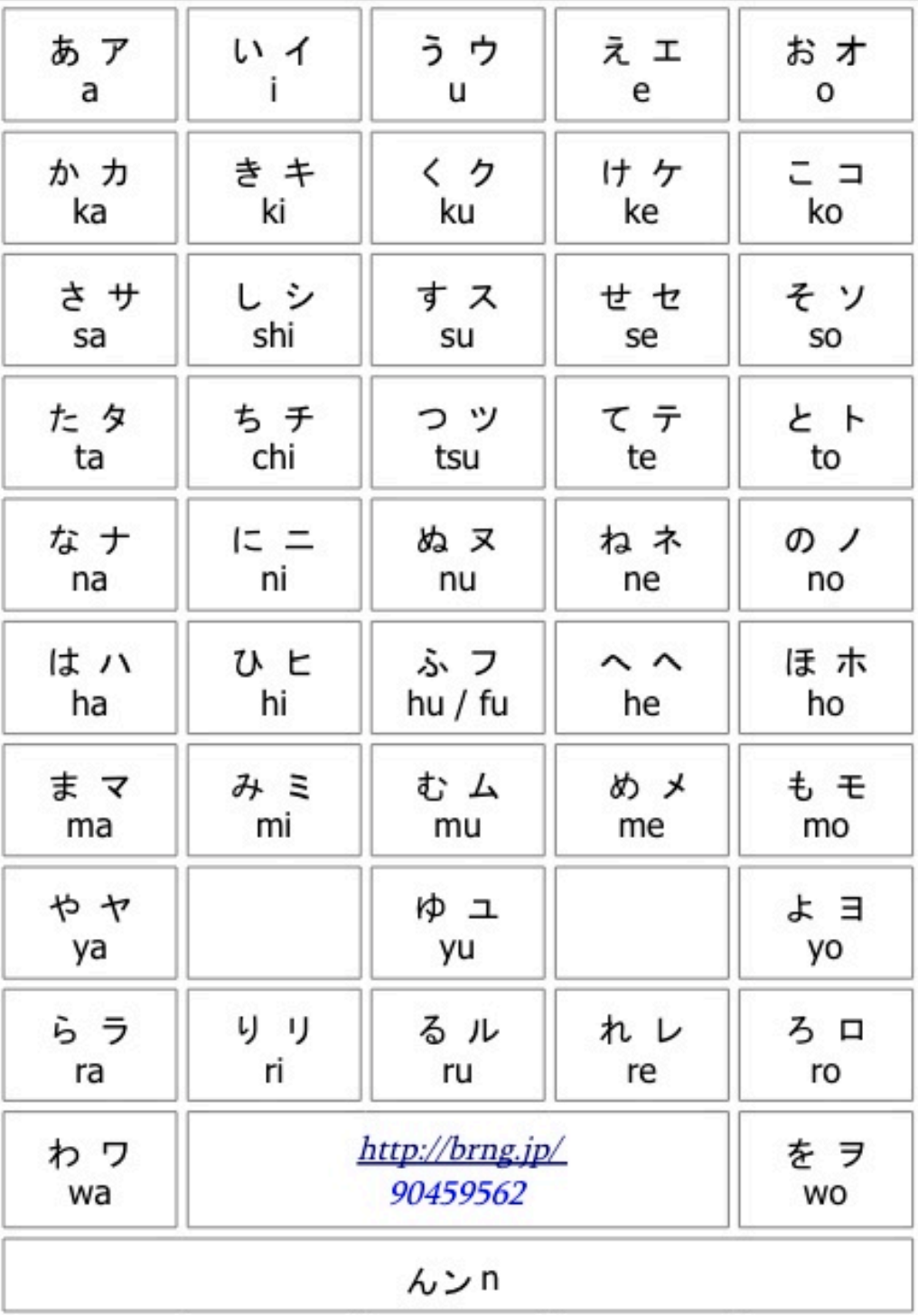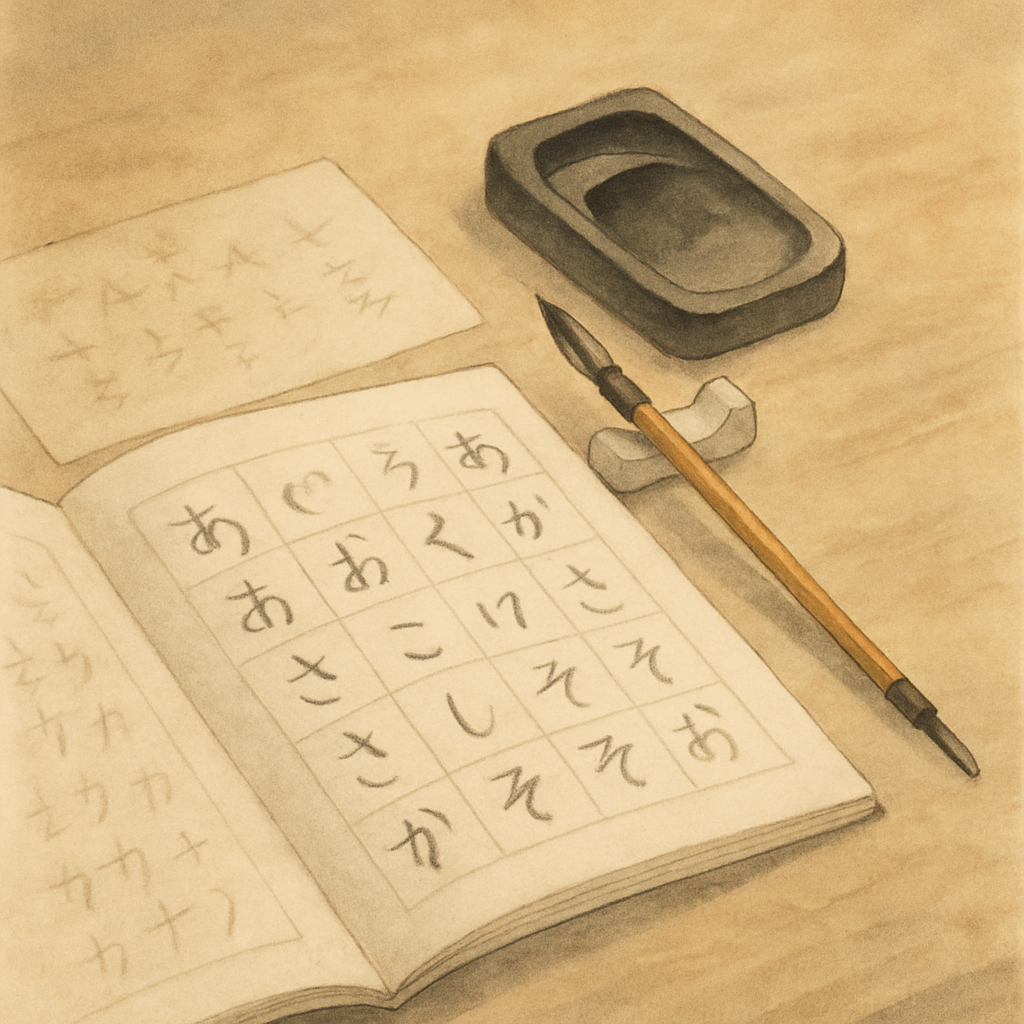In the last lesson of this series, we covered the three character sets that make up the Japanese writing system: Hiragana, Katakana, and Kanji.
This lesson will focus mainly on the first two sets of characters, Hiragana and Katakana. Though these two sets are made up entirely of different characters and have quite different functions in written Japanese, we will approach them together because they each contain 46 basic characters that cover the exact same 46 sounds.
Let's begin the lesson by learning about these sounds.
The 五十音 (gogyūon)
First, some context: in Japanese writing, each individual character of Hiragana and Katakana is simply called a 仮名 (kana), and each 仮名 (kana) represents exactly one sound.
If you're learning Japanese from an English background, this is a pretty good thing. Pronunciations in Japanese don't vary depending on the other characters around it, or where they are placed in a word, or just randomly like they sometimes do in English. Again, each Japanese 仮名 (kana) represents only one sound.
The traditional way to order Japanese 仮名 (kana) (kind of like alphabetical order in English) is called the 五十音 (gogyūon), or the Fifty Sounds. Below is a 五十音 (gogyūon) chart showing all of the Hiragana (left) and Katakana (right) on top with Roman character transliterations below.

The chart may seem large, but there is no need to be intimidated. As you might notice, the 五十音 (gogyūon) Fifty Sounds name refers to the 5 x 10 grid on which the chart is laid out. Even better, it's pretty simple to see why the characters are arranged in this way.
Across the top, you can see the 5 ending sounds, called 母音 (boin) in Japanese, that will be carried down through each column: あ (a), い (i), う (u), え (e), and お (o).
Then, you will also notice that each row of the chart corresponds to a different starting sound, 子音 (shiin) in Japanese. For example, all of the characters in the second row start with a 子音 (shiin) sound most similar to the English "k." We call these rows according to the first sound on the left, so the second row would be the か行 (ka gyō, ka row).
Finally, there is a lone character stranded at the bottom of the chart outside of the grid. This is the one and only special sound that stands alone, ん (n).
Hopefully, you can see that all of this will make learning these characters and their pronunciations even easier, because really all you need to learn is 10 starting sounds, 5 ending sounds, and ん (n).
One last important note: despite the romanizations in the chart above, remember that these sounds are fundamentally different from the ones you're familiar with in English. Even if we can express most of these sounds using Roman characters, these transliterations are only the closest representation possible. The sounds themselves have nothing to do with the sounds from any other language. When you are learning the characters, be sure to associate the characters with the sound rather than the transliteration.
Now, let's talk about the first set of characters organized according to the 五十音 (gogyūon): Hiragana.
Hiragana
This is the most important set of 仮名 (kana) in Japanese. As discussed in the last lesson, these characters are used in a variety of ways, including most grammatical constructions in sentences and as pronunciation guides for the other character types. For all intents and purposes, you could call this the "main" or "standard" set of 仮名 (kana). As mentioned before, there are 46 Hiragana characters, and it can be hard to identify them with 100% accuracy without simply learning the characters, but generally you can recognize Hiragana by their low stroke count and "curved" strokes.
Here you can find japanesefromjapan.com's resources for learning Hiragana, including worksheets sourced from Japanese elementary schools that will teach you how to recognize and write the characters.
Katakana
The second set of 仮名 (kana) in Japanese is mainly used to emphasize certain words or spell out foreign words. In general, these characters have a closer relationship with the sounds they represent. These 46 characters can be recognized by their "blocky" shapes.
Here you can find japanesefromjapan.com's resources for learning Katakana.
Character Variations and Combinations
If you've read some of our lessons here at japanesefromjapan.com, you might be used to us telling you that other Japanese learning resources have been tricking/lying to you in some way or another.
Unfortunately, this time, it's our turn to come clean about something.
When we started this lesson by saying that Hiragana and Katakana only consist of 46 sounds, that wasn't exactly true. There are technically three small variations you can make to change the sounds of certain Hiragana and Katakana characters.
But don't be mad, we only said that because these ones are easy to remember given what we've already learned.
濁点 (dakuten)
The first variation you will see is called the 濁点 (dakuten). This variation involves adding a ゛ mark to a given Hiragana or Katakana character. This mark indicates that you should change the pronounced sound of the character by activating your vocal cords at the beginning of the syllable.
That's a fairly vague explanation, so let's look at some examples.
は (ha) changes to ば (ba) when you add the 濁点 (dakuten). If you pronounce each sound in turn while touching your hand to your neck, you will feel the difference in vibration of your vocal cords. This gives you an idea of the sound change that we're looking for. You will feel a similar vibrational change if you do the same while you pronounce カ (ka) and ガ (ga).
This can be done with a variety of different 仮名 (kana), but if you remember this general change in sound, you should be able to learn the pronunciations quite easily.
半濁点 (handakuten)
The second variation of Hiragana and Katakana characters is the 半濁点 (handakuten). Looking at the name, you might guess that this variation is quite similar to the 濁点 (dakuten) (if you don't recognize it, the first kanji, 半, means "half" or "partial"). Using it is simple, too, just add ゜ to a given character like we added ゛ for the 濁点 (dakuten).
Luckily for us, 半濁点 (handakuten) can only be done with the 5 sounds of the は行 (ha gyō, ha row) kana. The effect of this variation is similar to the 濁点 (dakuten) described before in that you engage your vocal cords, except the sound you make with your mouth should be slightly different, a little more "forward" in your mouth. As a point of reference, this sound is often romanized as "p" as opposed to 濁点 (dakuten)'s "b." That means that, for example, ぱ (pa).
Combination Sounds
The final way to change the sound of a given 仮名 (kana) is to add a second, smaller 仮名 (kana) immediately afterward. These combinations are also pretty easy to learn because in most cases you simply combine the sounds of the two 仮名 (kana). For example, if you see きょ (kyo), it's simply a combination of き (ki) and よ (yo).
The one exception to this rule is if you see the small っ or ッ 仮名 (kana). This character instead indicates that you should extend the starting sound of the following 仮名 (kana). For example, よって (yotte) would be pronounced similar to "yotte," lengthening the t sound at the beginning of て (te).
Conclusion
We've gone into a lot of detail in this lesson. We've learned the standard sounds in Japanese according to the 五十音 (gogyūon), as well as the two character sets that it represents and some of their uses and variations.
So, what's left? Only memorizing each and every Hiragana and Katakana.
Now, I understand that this might sound like a lot of work, especially if you're just starting out. However, hopefully with the knowledge from this lesson you will realize that memorizing these 92 characters is not that difficult, and will only get easier and easier as you continue to immerse yourself in Japanese. As you approach memorizing the 仮名 (kana), remember that all 92 characters really only represent 46 unique sounds, which are actually only a combination of 10 different starting sounds and 5 ending sounds, plus 1 special sound.
Again, you can visit this site's Hiragana and Katakana learning sections to find resources that will help you learn the Hiragana and Katakana.
It's also hard to understate how useful learning these characters will be to your Japanese learning journey, unlocking huge amounts of real Japanese content and information for your consumption without having to seek out translations or transliterations, not to mention the wealth of content for which translations do not exist that will now be at your fingertips. You can do it!
In the next lesson of our Reading and Writing in Japanese series, we will learn more about the final writing system in Japanese: Kanji. Before you move on, we would recommend getting your feet wet by at least making a first pass at learning the Hiragana, as it will be very useful.
Until next time,
これからもよろしくお願いします。
Kore kara mo yoroshiku onegaishimasu
